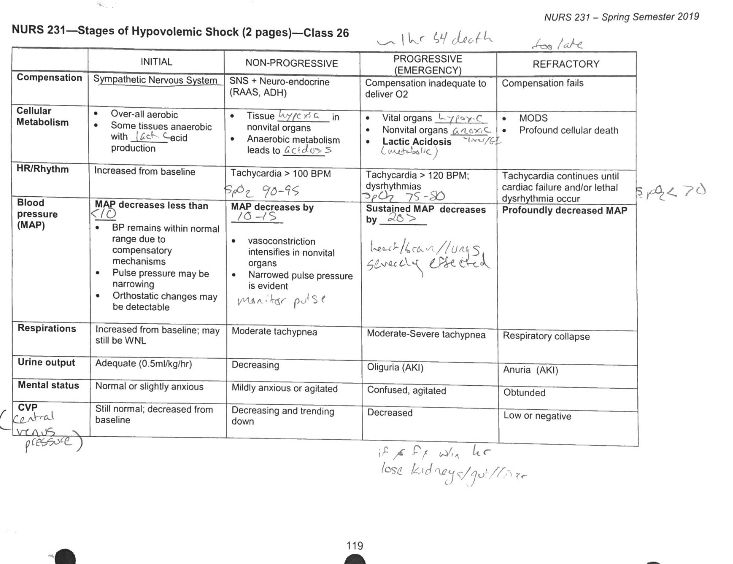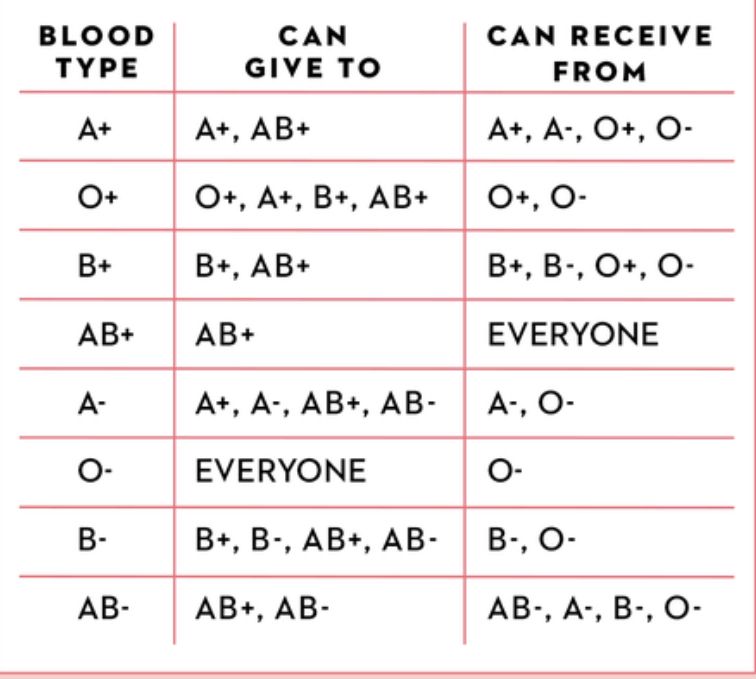Shock (and Blood Loss)
Broadly stated there are two categories of shock, psychological and physiological.
Psychological shock comes from witnessing or experiencing a traumatic event; such as a very stressful break up, a car accident, or natural disaster.
In an over simplification a person's brain might go 'numb' to the point where they can't think straight, can't react appropriately- a person might be overly angry/weepy/hysterical-, or might go catatonic (unresponsive while still technically conscious). In movies you might see paramedics placing blankets over individuals to try and help ground them back to reality.
I personally have had one experience with shock after a nasty car accident (that all parties involved miraculously walked away from). In the moment I held it together because I was focusing on making sure my family members were okay, but as soon as we got the hospital and I was put on a gurney to get checked out that's when I went numb (I also had a concussion so I can blame that too). I was still fairly aware of what was going on around me but it's like my brain was moving in slow motion. When I was asked questions I couldn't remember the words needed to respond accurately and all my limbs felt like lead. That initial 'numbness' only lasted maybe an hour for me, but the length varies depending on the individual.
From traumatic events a person could develop what's called Acute Stress Disorder (ASD), or Post Traumatic Stress Disorder (PTSD- which differs from ASD if symptoms persist beyond 1 month) which I plan to get into further in another chapter.
~~~~~~~~~~~~~~~~~~~~~~~~~~~~~~~~~~~~~~~~~~~~~~~~~~~~~~~~~~~~~~~~~~~~~~~~~~~
Physiological shock comes when the body can no longer maintain homeostasis (keeping the internal body regulated when the external environment changes) - typically in the form of impaired hemostasis (blood oxygen and nutrients getting from the vessels to their intended target).
There are several different reasons why this can occur such as sepsis (see earlier chapter for full details), hemorrhage (decrease in blood volume), cardiogenic- from the heart- (heart attack- blockage in the heart prevents blood flow), disruptive (general term meaning something else is initiating decrease of perfusion such as anaphylaxis or spinal cord damage) among others.
While each of the above might have somewhat different actions, the end result is lack of blood perfusion. Symptoms of such can include worsening hypotension (low blood pressure), increased heart rate to try offsetting decreased BP, difficulty breathing, decrease GI motility (end result constipation or ileus- complete halt of peristalsis [action used to move waste through the intestines]), the skin can get cool and clammy and localized edema (swelling) occurs since blood vessels often dilate allowing fluid to pool, dizziness/decreased level of consciousness and mental orientation (person/place/time)/potential coma since blood isn't getting to the brain, acute kidney injury (often presented in the form of decreased urine output).
~~~~~~~~~~~~~~~~~~~~~~~~~~~~~~~~~~~~~~~~~~~~~~~~~~~~~~~~~~~~~~~~~~~~~~~~~~~~~~~~
Blood loss in general:
Disclaimer: What I'm going to put is intended purely for academic purposes. I am aware a person can take this information out of the realm that I intend this to be used for. To put it candidly if you or someone you know is having suicidal thoughts/ideation please go to a trusted friend/family member/religious leader. No matter your situation or background I can 100% guarantee you matter and have value simply in the fact that you are you. I've included the US suicide hotline number at the bottom of this chapter as a resource.
-There are areas of the body that if they get hit or cut are worse than others. Wrists, the back of the knees, the jugular vein/carotid artery in the neck (the head in general isn't great to get hit or stabbed), and puncture wounds to the trunk/abdomen, especially in the lung region, are all dangerous points.
-When a person has hypovolemia the blood vessels constrict to promote blood flow to the heart and brain above all other organs. This can result in multi-organ system failure if the other organs are left without adequate blood flow for too long.
-Head wounds bleed a lot. In that case it's a bit better to go by how alert and oriented the person is as you get their bleeding under control. Pro tip: For nose bleeds don't tilt your head back or lay flat, this increases the risk of choking on the blood. Stay upright, lean slightly forward and pinch your nostrils closed. Don't swallow any blood in your mouth because that can cause nausea and vomiting.
-If an artery is severed your character is in big trouble. This is distinguished from a venous cut by the fact blood will spurt from the wound at intervals rather than a continuous ooze. Pressure, as much as can be managed, needs to be applied ASAP. If needed, this means plugging the artery with a finger or sterile device until it can be sewed or cauterized that might mean the difference between the person surviving or not.
-Should the person be bleeding profusely from an arm or leg, elevate the extremity above the heart. Gravity will help keep the blood from flowing up and out the wound as easily.
-Tourniquets are a later resort since you're stopping the blood flow to the entire extremity below its placement. If left too long everything below the tourniquet may have to be amputated due to tissue death, but if that's the only measure left to stop/slow the bleeding a person is able to live without an arm or leg.
-If a person has been impaled with an object do not remove it until you are ready to close the wound. That object, as painful as it might be stuck in someone, very likely is keeping the person from bleeding worse than they will be once it's removed.
Below is a chart that helps break down the signs and symptoms that accompany hypovolemic shock.

An adult typically has about 1.2 to 1.5 gallons (~4.5 to 5.5 Liters) of blood in their body. When someone donates blood they typically take 1-2 pints (~475 to 950 mL). At that point someone might feel a bit lightheaded but otherwise should be fine.
When 1 Liter of blood is lost you'll probably start seeing symptoms listed in the "Initial" category in the photo. If measures are taken the person will probably be laid up for a couple days but they should still be fine.
2 Liters lost puts them in about the "Progressive/Emergency" category. They definitely need a blood transfusion and to stop whatever is causing the lack of blood. Definitely running the risk of death here.
More than 2.5 Liters and it's 100% pushing the "Refractory" section. Extremely likely they'll die unless your story has magic or incredibly advanced medicinal measures.
Side note: Blood transfusions
There are four (major) blood types A, B, AB and O. The Rh factor is what determines if the blood is "+" or "-". Positive blood types can receive negative blood, but negative can't receive positive. AB+ is considered the universal receiver, because it can take any blood type. O- is the universal donor because it can be given to any blood type. Below is a chart that breaks down who can get what.

Someone might have a reaction to the transfusion, especially if they've had multiple transfusions in the past. Mild symptoms include itching and hives. However if someone receives the wrong blood type the reactions can almost be worse than having low blood volume. The body begins attacking the blood because it's seen as foreign (not self). Severe symptoms include fever, chills, chest or back pain, respiratory distress, decreasing blood pressure and urine abnormalities.
US Nat'l Suicide Hotline # 1-800-273-8255
Bạn đang đọc truyện trên: AzTruyen.Top